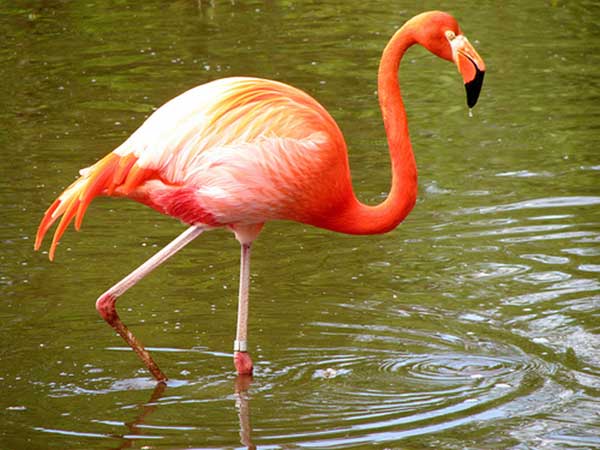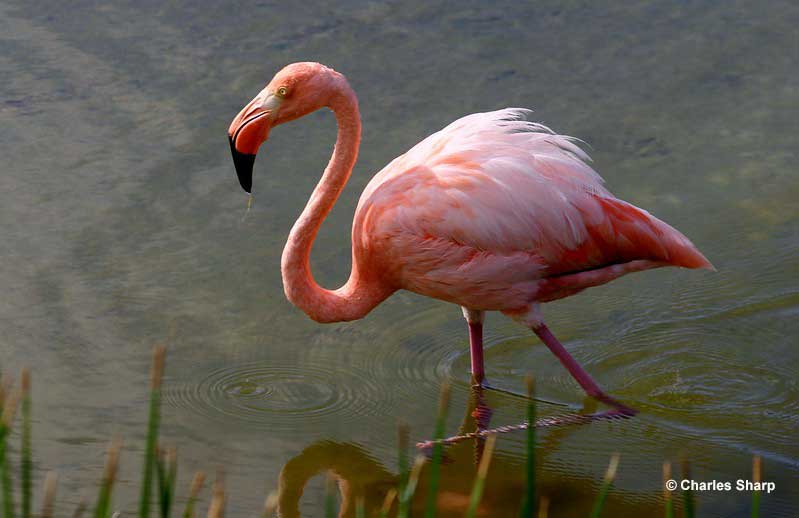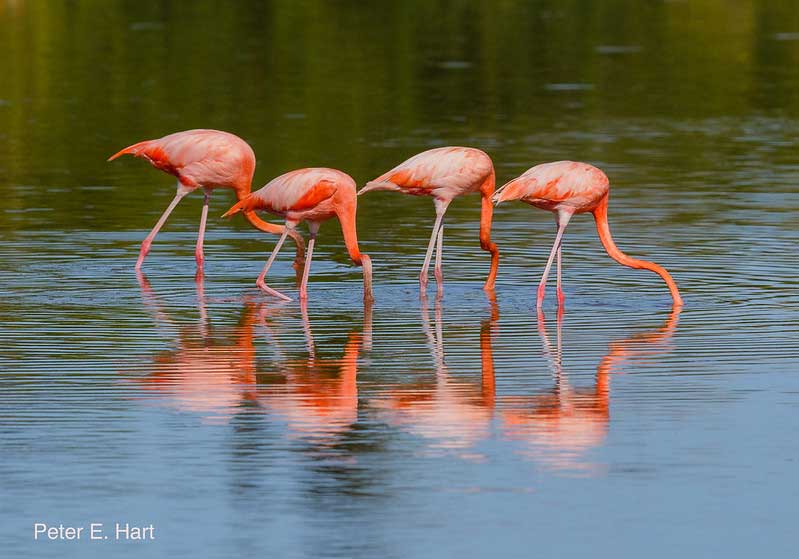The American Flamingo (Phoenicopterus ruber), a striking wading bird found in the Americas, stands out with its brilliant pink plumage and distinctive long legs and neck.
It thrives in coastal and inland salt and brackish water habitats, using its specialized bill to filter a variety of food from the water. There’s more to them, though, so read on!
On this page
Identification
The American Flamingo is the largest flamingo species in the Americas, measuring 47-57 inches tall. Among all bird species, its long neck and legs are the largest proportionally to its body size.
The bills, pale in color with a distinctive black tip, are notably large, with the lower mandible being bigger than the upper one. Since the bills are heavy and their necks long, they often rest their heads on their bodies to prevent neck muscles from fatiguing.
Both the male and female American Flamingos have the same plumage. They are primarily pink, have red wing coverts, and have black flight feathers that are only visible in flight. The species is sexually dimorphic in size and in regarding the time it takes to acquire adult plumage.
Typically, females are smaller and lighter but acquire their adult plumage earlier than males.
Juvenile American Flamingos have overall gray-looking plumage. Their undersides are more white, and they have visible black on their wings. They also have gray legs and bills instead of the pale pink ones the adults have.
In flight, they keep their neck and feet extended.
Vocalizations
American Flamingos live in sizable colonies of up to tens of thousands of birds, so effective communication is extremely important. They mainly communicate via vocalizations and also body language.
American Flamingo’s call is similar to that of a honking goose. They do that both in flight and on land but on land the call becomes quieter and softer. Adults also communicate via physical displays that can be used to establish dominance and attitudes. Head placement and ruffled feathers can help determine aggressiveness toward others.
Food
American Flamingos are primarily carnivorous, but they also eat plant matter. They are not particularly selective, consuming anything that they can capture with their bills. This includes microscopic organisms, both aquatic and terrestrial worms, nematodes, crustaceans, insects, mollusks, larvae, small fish, and algae.
They forage by wading in shallow waters, stirring up sediment at the bottom. This action serves to dislodge various aquatic organisms from their hiding places and makes them more accessible for feeding. They then submerge their head beneath the water while keeping their body upright, drawing in both water and potential food items into their bill.
The bill is equipped with rows of intricate, comb-like structures along the inner edges. This arrangement forms a natural sieve or filter.
Learn more: 100+ birds facts and statistics
By closing its bill and expelling excess water through specialized slits, the flamingo effectively captures small organisms within the bill’s confines. The bird also uses its tongue to further manipulate the flow of water and food through its filtering system.
Nesting and Eggs
American Flamingos don’t adhere to a fixed seasonal pattern. They can have offspring any time of the year. However, the colonies tend to synchronize their breeding efforts with the warmer seasons that follow rains. That is because there will be more food and more suitable mudflats for nesting.
They typically opt for monogamy and mated pairs often remain together for years.
Male American Flamingos initiate the courtship and when the female is interested, she will mirror his dance. This elegant choreography continues until one of the pair decides to mate or discontinue the courtship. Once paired up, they will often stand, eat, and sleep together.
Once the mating ritual is concluded, the pair starts building a nest. Males take the lead in the initial construction, but as the process advances, both birds actively contribute to its development.
American Flamingo nests take the form of circular mounds, approximately twelve inches high, with a central depression designed to cradle the egg. They’re made of mud and occasionally also include bits of vegetation, feathers, and twigs.
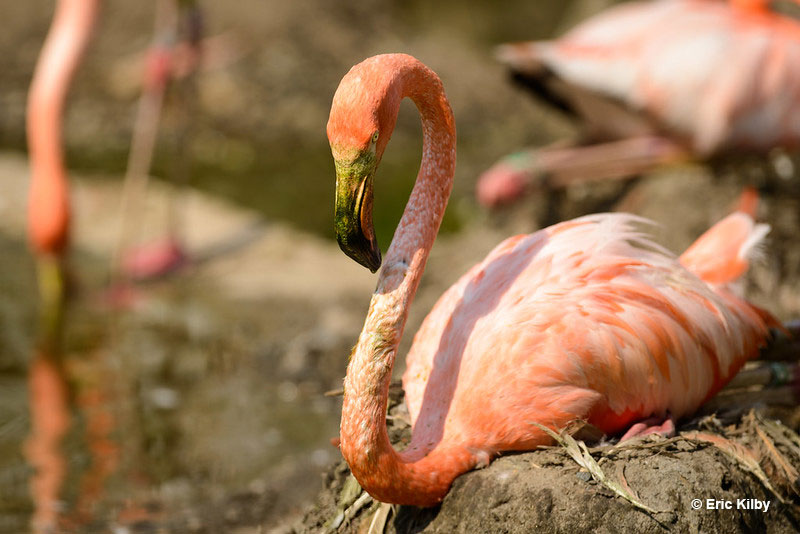
American Flamingo eggs are large, about the size of an orange, and milky white. Each clutch contains 1-2 eggs. Generally, however, there’s only one egg per clutch and even if there are two, the second one rarely hatches.
Both parents take turns incubating the eggs, which takes about 28-32 days. One will stay with the eggs while the other forages.
Hatchlings remain at the nest for the initial five to eight days and then gather in social clusters (also known as “creches”) with other chicks. The younglings fledge 65-90 days after hatching. Both parents take care of them until that.
Current Situation
American Flamingos range across various subtropical and tropical regions of the Americas. In South America, they’re found across the northern areas such as coastal Colombia and Venezuela, in the Galapagos Islands, and in northern Brazil.
In Central and North America, they can be found in Mexico, in the West Indies, and in Florida in the U.S. American Flamingo’s habitats include mudflats, inland lakes, shallow, brackish coastal lakes, and saline lagoons – places that have loose mud for nest building and sufficient food supply.
Related: Can flamingos fly?
American Flamingos are listed as of least concern on the IUCN Red List. They have a rather large range and will readily migrate to other locations if their habitat is disturbed or food becomes scarce.
Facts
- The shape and structure of flamingos’ bills are rather uncommon and highly specialized. The lower and upper mandibles are “reversed” in a sense to better suit their habit of feeding upside down. In the animal and bird kingdom, the upper mandible is usually fixed, whereas the lower one moves. When it comes to flamingos, it’s the other way around.
- The American Flamingo has had many names. It was formerly known as the Rosy Flamingo and is also known as the Caribbean Flamingo. Previously, it was considered to be the same species as the Greater Flamingo.
- Although they generally prefer monogamy, American Flamingos may also form trios or even quartets. In trios, there’s a dominant pair and a subordinate. If the subordinate is female, then there’s a power struggle between the females. If the subordinate is a male, then there’s generally no fighting and the subordinate will become the main caregiver for the younglings. In quartets, the subordinate male won’t have access to the nest, whereas the other three take care of the nest and the females get along better.
- American Flamingo chicks start to call while they’re still inside the egg and the parents will call back. This way, the parents and the chick will bond, and once hatched, they will recognize each other’s unique vocalizations.
- American Flamingos filter-feed and thus ingest a lot of salt water. They have salt glands that help expel excess salt from their body so that it wouldn’t cause dehydration.
Similar Species
American Flamingos have quite a few bird species that resemble them when it comes to their build.
This includes storks, herons, and egrets and you might even confuse a Great Blue Heron or a Sandhill Crane for a juvenile American Flamingo.
However, there’s only one species in the United States that also has the same coloration as this flamingo, and it is the Roseate Spoonbill.
Roseate Spoonbill
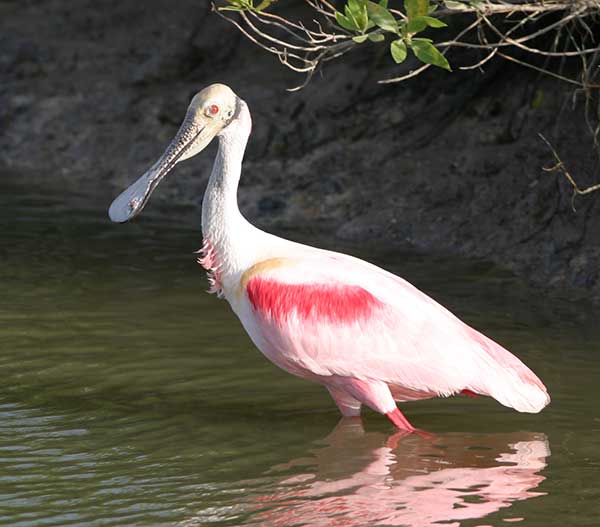
The Roseate Spoonbill can be found in North, Central, and South America. In North America, they’re generally found in Florida, Texas, and Louisiana. They inhabit wetlands, mangroves, forested swamps, and bays.
Roseate Spoonbills and American Flamingos both have pink plumage, long necks, and long, thin legs. However, American Flamingos have longer necks and keep them in a more pronounced S-shape.
In flight, you can tell it’s a flamingo by its black flight feathers. If you get close enough to distinguish the shape of its bill, then Roseate Spoonbills have a longer, fully pale spoon-shaped bill whereas the American Flamingo has a shorter bill with a black tip.
Frequently Asked Questions
Where do the American Flamingos live?
American Flamingos live in shallow salt or brackish water lakes, mudflats, and saline lagoons across subtropical and tropical regions of the Americas. They range from southern Florida in the U.S. to northern Brazil in South America.
Why are American Flamingos pink?
American Flamingos are pink due to the carotenoids they get from their food.
Are flamingos native to the US?
Flamingos were once native to Florida, disappeared, and were then reintroduced in about 1925.
What kind of noises do flamingos make?
Flamingos honk like geese. They can also grunt or growl.
Can a flamingo fly?
Flamingos can fly and they will readily migrate to other places if food is scarce or the conditions are no longer favorable.

